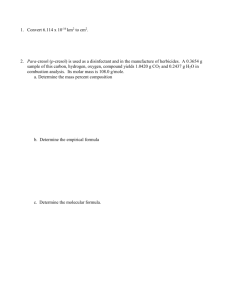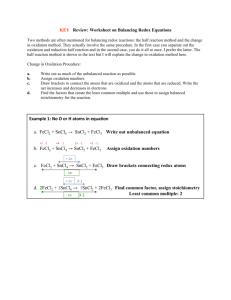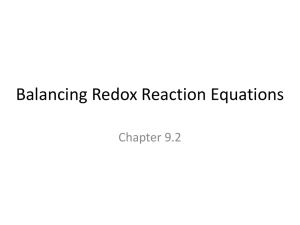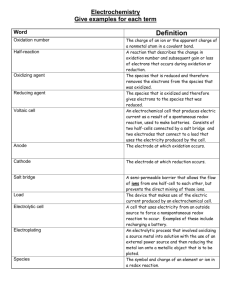Balancing Redox Reactions
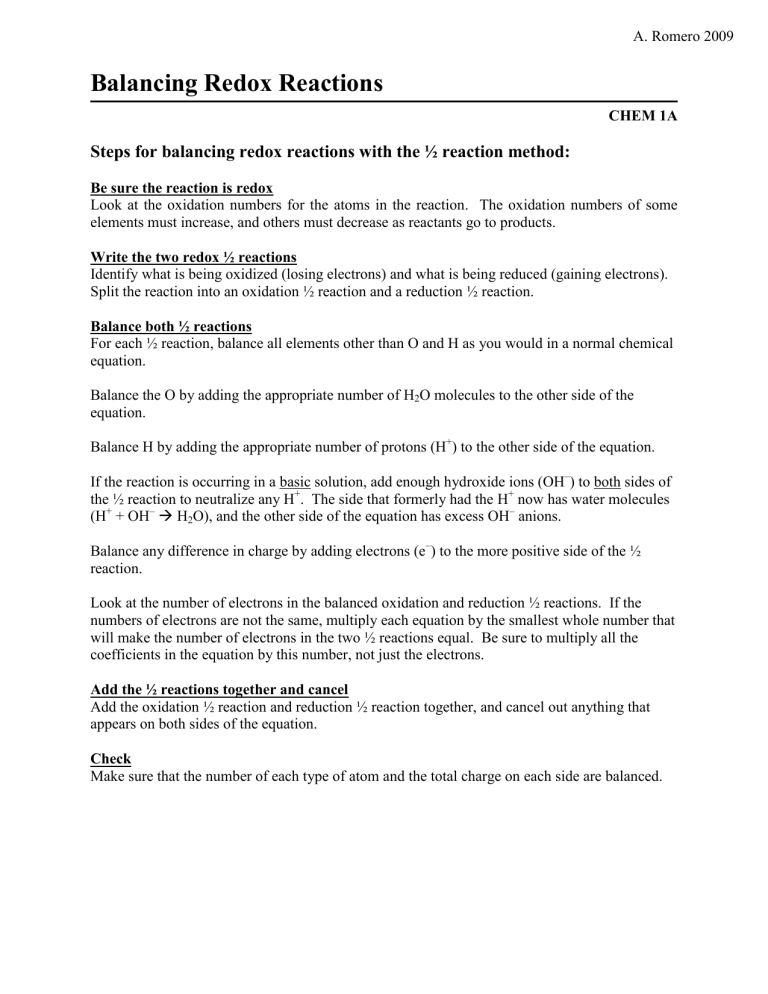
A. Romero 2009
Balancing Redox Reactions
CHEM 1A
Steps for balancing redox reactions with the ½ reaction method:
Be sure the reaction is redox
Look at the oxidation numbers for the atoms in the reaction. The oxidation numbers of some elements must increase, and others must decrease as reactants go to products.
Write the two redox ½ reactions
Identify what is being oxidized (losing electrons) and what is being reduced (gaining electrons).
Split the reaction into an oxidation ½ reaction and a reduction ½ reaction.
Balance both ½ reactions
For each ½ reaction, balance all elements other than O and H as you would in a normal chemical equation.
Balance the O by adding the appropriate number of H
2
O molecules to the other side of the equation.
Balance H by adding the appropriate number of protons (H
+
) to the other side of the equation.
If the reaction is occurring in a basic solution, add enough hydroxide ions (OH
–
) to both sides of the ½ reaction to neutralize any H
+
. The side that formerly had the H
+
(H
+
+ OH
–
H
2
O), and the other side of the equation has excess OH
–
now has water molecules
anions.
Balance any difference in charge by adding electrons (e
–
) to the more positive side of the ½ reaction.
Look at the number of electrons in the balanced oxidation and reduction ½ reactions. If the numbers of electrons are not the same, multiply each equation by the smallest whole number that will make the number of electrons in the two ½ reactions equal. Be sure to multiply all the coefficients in the equation by this number, not just the electrons.
Add the ½ reactions together and cancel
Add the oxidation ½ reaction and reduction ½ reaction together, and cancel out anything that appears on both sides of the equation.
Check
Make sure that the number of each type of atom and the total charge on each side are balanced.
COLOR CODING KEY:
Balancing Redox Reactions using the ½ Reaction Method
Steps:
Split overall equation into two ½ reactions
Balance elements other than O & H
Balance O with H
2
O
Balance H with H
+
If in basic solution, add enough OH
−
to both sides to neutralize the H
+
Balance charge with e
–
Multiply through to make # of e
−
in the two ½ reactions match
Add ½ reactions back together
Cancel out species that appear on both sides
Check both sides of the equation for same # atoms and overall charge
Example #1:
In the following unbalanced redox equation, the oxidation number of each atom has been labeled, the oxidizing and reducing agents have been identified, and the reaction has been balanced using the ½ reaction method. ox red
As
2
O
3(s)
+ NO
3
-
(aq)
H
3
AsO
4(aq)
+ NO
(g)
+3 each
−2 each
+5
−2 each
+1 each
+5
−2 each
+2
−2
NO
3
−
Oxidizing Agent: ______________
As
2
O
3
Oxidation ½ Reaction:
As
2
O
3
2 H
3
AsO
4
+ 5 H
2
O
+ 4 H
+
+ 4 e
− x 3
Reduction ½ Reaction:
unbalanced
NO
3
−
NO
+ 4 H
+
+ 3 e
−
+ 2 H
2
O x 4
3 As
2
O
3
+ 15 H
2
O
6 H
3
AsO
4
+ 12 H
+
+ 12 e
−
Add & Cancel
7 4
3 As
2
O
3
+ 15 H
2
O + 4 NO
3
−
+ 16 H
+
+ 12 e
−
6 H
3
4 NO
3
−
+ 16 H
+
+ 12 e
−
4 NO + 8 H
AsO
4
+ 12 H
+
+ 12 e
−
+ 4 NO + 8 H
2
O
2
O
Balanced Redox Equation:
3 As
2
O
3
+ 7 H
2
O + 4 NO
3
−
+ 4 H
+ 6 H
3
AsO
4
+ 4 NO
Check:
As 6
O 28
H 18
N 4
charge 0
Example #2: Occurring in basic solution
In the following unbalanced redox equation, the oxidation number of each atom has been labeled, the oxidizing and reducing agents have been identified, and the reaction has been balanced using the ½ reaction method. red ox
NO
2
-
(aq)
+ Al
(s)
NH
3(g)
+ AlO
2
-
(aq)
+3
−2 each
0
−3 +1 each
+3
−2 each
NO
−
Oxidizing Agent: ______________
Oxidation ½ Reaction: Reduction ½ Reaction:
Al
AlO
2
−
+ 2 H
2
O
+ 4 OH
−
+ 4 H
+
+ 4 OH
−
2
4 H
2
O
+ 3 e
− x 2
2 Al + 8 OH
−
2 AlO
2
−
+ 4 H
2
O + 6 e
−
NO
2
−
NH
3
+ 2 H
2
O
+ 7 H
+
+ 7 OH
−
5
7 H
2
O
+ 7 OH
−
+ 6 e
− x 1
NO
2
−
+ 5 H
2
O + 6 e
−
NH
3
+ 7 OH
−
Balanced Redox Equation:
1
2 Al + 8 OH
−
+ NO
2
1
−
+ 5 H
2
O + 6 e
−
2 AlO
2
−
+ 4 H
2
O + 6 e
−
+ NH
3
+ 7 OH
−
2 Al + OH
−
+ NO
2
−
+ H
2
O
2 AlO
2
−
+ NH
3
Check:
Al 2
O 4
H 3
N 1
charge 2−
